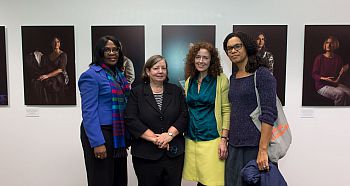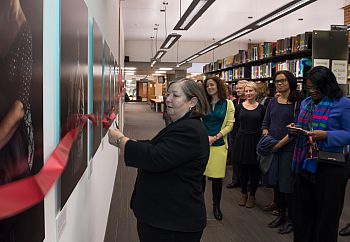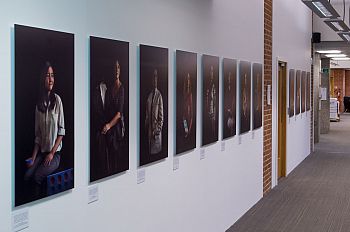Female academics celebrated with permanent display on campus
A series of specially commissioned portraits that reveal the personal motivations of female academics at Sussex has now been permanently installed on the first floor of the Library.
 R-L: Professor Bugewa Apampa; Professor Clare Mackie, Pro-Vice-Chancellor (Teaching and Learning); Dr Michelle Lefevre; and Dr Pamela Kea.
R-L: Professor Bugewa Apampa; Professor Clare Mackie, Pro-Vice-Chancellor (Teaching and Learning); Dr Michelle Lefevre; and Dr Pamela Kea.

The academics who were invited to take part represent a range of career stages; some are leading research in the most competitive areas, while others are at the beginning of their academic careers.
The Twelve Women in Academia series was unveiled on Wednesday (16 November) by Professor Clare Mackie, Pro-Vice-Chancellor (Teaching and Learning).
Unveiling the portraits, Professor Mackie said: “It’s really lovely to put some portraits of female academics in our Library, to bring inspiration to students across the University – not just female students, but also male students who would like to see more of a female presence.
“I would like to thank the group of academics who posed for the portraits and engaged quite passionately in the process.”
The women are all pictured with an object that either represents an aspect of their work or has had some personal significance in their career.
Professor Vinita Damodaran, for example, holds in her image palm-leaf manuscripts from her home region in Southern India that contain valuable knowledge about plants and plant medicine.
Professor Damodaran, a Senior Lecturer in South Asian History, is using indigenous and colonial archives such as these to better understand how previous generations have lived in hostile environments that could become more common as the effects of climate change become more apparent.
The project also includes Dr Lily Asquith, a Royal Society Dorothy Hodgkin Research Fellow who works to analyse data collected from the ATLAS experiment at the Large Hadron Collider, CERN.
Dr Asquith started her journey towards academia more than 10 years ago as a new mother with no science qualifications, and is now developing novel methods to uncover signatures of new physics as part of her research.
Professor Damodaran, Dr Asquith and the other 10 women were photographed by fine-art photographer and Sussex alumna Miss Aniela, who took inspiration from the work of 17th-century Dutch artist Rembrandt to create an almost oil painting-like feel to each image.
Explaining the portraits, Miss Aniela said: “What I’ve been doing is shooting them as a set of portraits in this low-key, dark, moody, almost Rembrandt-inspired style, each pictured with a prop that relates to their practice or their personality.
“Each prop has been different for each woman and when the set is put together it becomes a series of interesting and conceptual portraits.”
There is a full gallery of the portraits available online along with videos of some of the academics involved.
